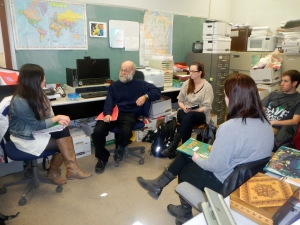I’m in the process of revisiting several resources that have influenced my choice of online teaching tools. This post focuses on the book by Steve Johnson (2011)—a thoughtful and concise compendium of his thinking about today’s “tech-savvy” (high school age) learners and how to prepare them for their digital future. He systematically evaluates over 30 “etools” he judges to be useful for engendering collaboration, creation, and publication across the curriculum, and offers concrete suggestions for how to get started (and how to keep up) as an instructor. Among the many tools that he recommends that I have personally found especially useful for my teaching at the college/university level are the following:
- I have grown to like Animoto as a vehicle for creating and sharing video-like productions, despite its constraints of needing to use Adobe Flash and accepting only MP3 formatted music files. I have elected to have an educational account with them. Here is an example of how I have used it.
- WordPress is now my blogging tool of choice and the blogging tool that I teach to students. I myself move back and forth between WordPress.com (“David in Carroll Land”) and WordPres.org (“Curious David in Carroll Land”). The latter gives me far more creative freedom (e.g. the use of plugins) but at an additional cost (both financial and time I need to devote to its higher learning-curve). Here is an example of a WordPress.com blog piece in which my student research assistants shared “sand box” activities while they explored for me the value of some beta version software which showed promise to me of eventually being useful in the classroom. Here, on the other hand, is a recent blog piece co-written with my students using the WordPress.org blogging software (which I still am at an early stage of mastering). Without doubt, my best etool evaluators are my highly trained student assistants.
- Google Docs is becoming an increasingly important tool for me. Indeed, I would love to devote the time to create a Google Apps course for our students. Richard Bryne, an educator thought leader whom I follow on Twitter and whose contributions I benefit from, has created a wonderful comprehensive guide to this tool.
Presently my students are more facile with this learning tool than I!. We regularly use it as a means of collaborating and sharing documents —photos, videos, journal articles, rough drafts, spreadsheets. Just today one of my senior research seminar students shared with me, on Google Drive, a wonderful video she had made of her interviewing her twelve-year-old son about his experiences with a form of Asperger syndrome. Keri and I shortly shall be incorporating this video and her insights about parenting such a special child into a blog piece as a first step in assisting her in writing a book to share her knowledge.


